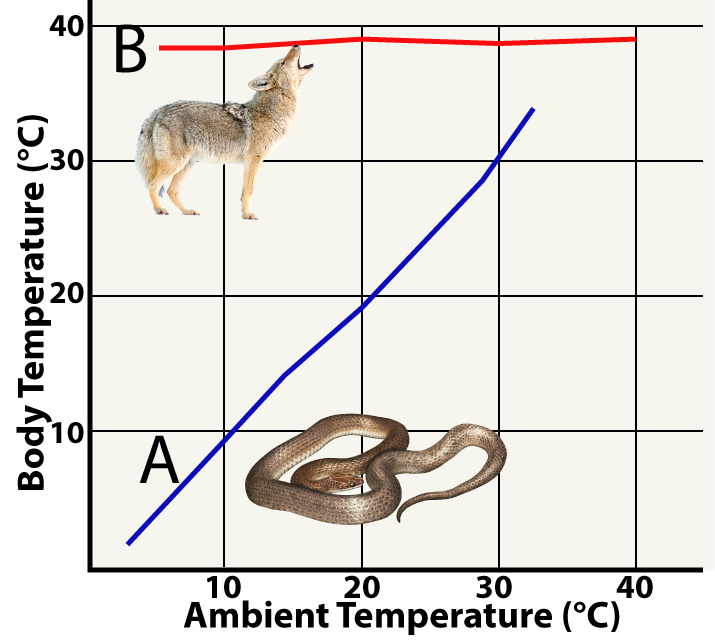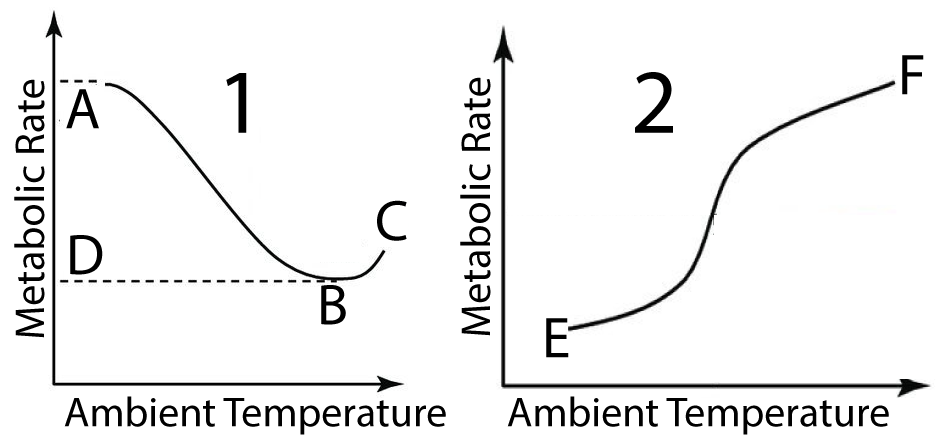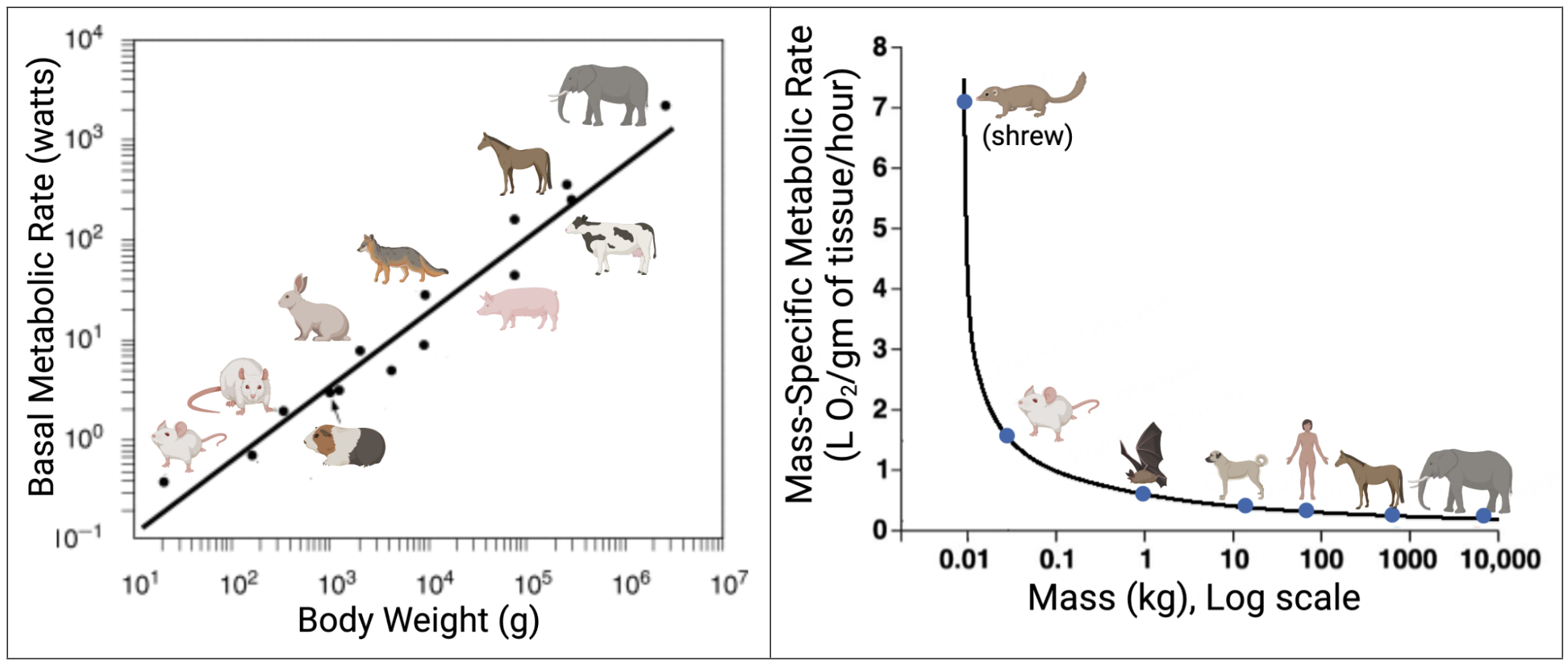1. Watch this Video
2. Study this Summary
Endotherms vs. Ectotherms

Endotherms
- Includes mammals, birds, and a few other species.
- Generate body heat internally through metabolic processes.
- Mostly maintain a stable internal temperature regardless of environmental changes.
- Endotherms have a variety of strategies for avoiding burning too much energy when cold.
- Some mammals hibernate, allowing their body temperature to drop.
- In bears, body temperature can drop from 38°C to 31°C.
- In the Arctic ground squirrel, body temperature can drop below the freezing point during their 8 month hibernation (though various adaptations keep these animals from freezing solid)
- Every night, hummingbirds drop into a state of inactivity called torpor, during which their body temperature can fall by 11°C from their daytime setpoint of 38°C. In a condition called extreme torpor, the body temperature can drop 27 °C.
- Some mammals hibernate, allowing their body temperature to drop.
Ectotherms
- Includes reptiles, amphibians, fish, and invertebrates.
- Body temperature fluctuates with environmental temperature.
- Require far less energy compared to endotherms.
- Ectotherms have a variety of strategies for regulating their body temperature.
- In larger animals such as lizards and snakes, this includes basking in the sun or resting in the shade.
- In honeybees, huddling together and moving their wing muscles generates heat that can raise the temperature of the hive in cold weather, or create air currents to cool the hive in warm weather.
Advantages of Each Strategy
- Endotherms:
- Can remain active in all seasons and temperatures.
- Dominant in cold environments (e.g., polar bears, penguins).
- Ectotherms:
- Need only a fraction of the energy required by endotherms.
- Example: A 400-pound alligator needs as few calories as a few slices of bread, while a similarly sized mammal would need an entire loaf.
Understanding Metabolism and Metabolic Rate
Metabolism is the sum total of all chemical processes occurring within an organism. It includes the inputs, processes, and outputs that sustain life.
- Metabolic Rate: The amount of energy an organism expends over a given time.
- Basal Metabolic Rate (BMR): The energy consumed by an organism at rest in a comfortable temperature.
How is Metabolic Rate Measured?
Metabolic rate can be measured using multiple methods:
- Oxygen Consumption: Measuring how much oxygen an organism uses.
- Carbon Dioxide Production: Tracking CO₂ output during respiration.
- Heat Production: Evaluating energy expended through heat loss.
Temperature and Metabolic Rate

- Ectotherms: Metabolic rate increases as environmental temperature rises.
- Endotherms:
- Metabolic rate is high at low temperatures to generate body heat.
- Falls to BMR in moderate temperatures.
- Rises at high temperatures due to cooling mechanisms.
Metabolism, Body Size, and Metabolic Scaling

- Larger endotherms have a higher absolute metabolic rate (e.g., an elephant needs more total energy than a mouse).
- Metabolic scaling: Relative metabolic rate (energy per gram of body mass) is much higher in small animals. Each gram of mouse tissue is consuming energy at a much higher rate than a gram of elephant tissue.
Comparison of Large vs. Small Mammals
| Animal | Weight | Daily Caloric Intake | Calories/day/gram | Heart Rate |
|---|---|---|---|---|
| African Elephant | 6,000,000 g | 70,000 kcal | 0.011 kcal/g | 30 bpm |
| Shrew | 1.8 g | 144 kcal | 80 kcal/g | 1200 bpm |
Physiological Consequences of Size and Metabolism
- Smaller animals have much faster metabolic rates, leading to:
- Higher heart rates (e.g., a shrew’s heart beats 1,200 times per minute).
- More frequent breathing (800 breaths per minute in a shrew).
- Rapid starvation risk (shrews starve within 4 hours without food).
- High food consumption relative to body weight (shrews eat 200% of their body weight daily).
- Larger animals, such as elephants, have much slower metabolic rates:
- Low heart rates (30 beats per minute).
- Four or five breaths per minute.
- Can survive for days without food.
- Eat about 4% of their body weight daily.
The Role of Surface Area to Volume Ratio in metabolic scaling
- Smaller animals have a higher surface area to volume ratio.
- This causes them to lose heat more easily, requiring a higher metabolic rate to maintain body temperature.
- As an animal increases in size, volume grows faster than surface area, reducing heat loss and energy demands.
3. Master these Flashcards
[qdeck bold_text=”false” qrecord_id=”sciencemusicvideosMeister1961-Energy Use in Organisms Flashcards, APBioVideoPath”]
[h]Energy Use in Organisms
[i]
[q json=”true” yy=”4″ unit=”8.Ecology” dataset_id=”AP_Bio_Flashcards_2022|128c05de35510″ question_number=”374″ topic=”8.2.Energy_Flow_Through_Ecosystems”] What’s the difference between an ectotherm and an endotherm?
[a] An endotherm is an organism that generates its heat internally through its metabolism. An ectotherm absorbs heat from the environment (for example, from the sun).
[q json=”true” dataset_id=”AP_Bio_Flashcards_2022|b439044b534c7″ question_number=”375″ unit=”8.Ecology” topic=”8.2.Energy_Flow_Through_Ecosystems”] Compare and contrast the benefits of being an endotherm or an ectotherm.
[a] Being an endotherm enables an organism to be active regardless of the environmental temperature. That’s why the predominant animals in the Arctic or Antarctic environments are mammals (think of polar bears) and birds (think of penguins). The disadvantage of being an endotherm is that it requires a lot of energy. Ectotherms can survive on about 1/10th of the food energy required by an endotherm of a similar mass.
[q json=”true” yy=”4″ unit=”8.Ecology” dataset_id=”AP_Bio_Flashcards_2022|1282906de7110″ question_number=”376″ topic=”8.2.Energy_Flow_Through_Ecosystems”] What are some strategies that ectotherms use to regulate their body temperature?
[a] Ectotherms have a variety of behavioral means of optimizing their body temperature. In larger animals such as lizards and snakes, this includes basking in the sun or resting in the shade. In honeybees, huddling together and moving their wing muscles generates heat that can raise the temperature of the hive in cold weather, or create air currents to cool the hive in warm weather.
[q json=”true” yy=”4″ unit=”8.Ecology” dataset_id=”AP_Bio_Flashcards_2022|12736e209d110″ question_number=”377″ topic=”8.2.Energy_Flow_Through_Ecosystems”] What is metabolic rate? How can it be measured?
[a] An organism’s metabolic rate is the amount of energy that the organism expends during a given amount of time. It can be measured by oxygen consumption, carbon dioxide production, or heat production.
[q json=”true” dataset_id=”AP_Bio_Flashcards_2022|2a44063e5605″ question_number=”378″ unit=”8.Ecology” topic=”8.2.Energy_Flow_Through_Ecosystems”] How can the metabolic rates of animals of different sizes be compared? What’s the general relationship between metabolic rate and size (and why)?
[a] To compare metabolic rates in animals that are of different sizes, we use the relative metabolic rate: the metabolic rate/unit of body mass.
Among endothermic animals (for example, mammals) the general rule is that as size increases, relative metabolic rate decreases. For example, a gram of mouse tissue metabolizes up to 10 times faster than a gram of elephant tissue. Why? Smaller animals have a larger surface area to volume ratio than do larger animals. As a result, smaller animals will lose heat more easily than larger animals will. To replace that heat, the smaller animal will need to perform more cellular respiration, increasing its relative metabolic rate.
[x][restart]
[/qdeck]
4. Tackle these Quizzes
4.1. Endotherms and Ectotherms
[qwiz qrecord_id=”sciencemusicvideosMeister1961-Endotherms and Ectotherms, APBioVideoPath”]
[h]Quiz: Endotherms and Ectotherms
[i]
[q]A(n) [hangman] gets its body heat from the external environment.
[c]ZWN0b3RoZXJt[Qq]
[q]A(n) [hangman] generates its body heat internally, usually as a by product of [hangman] [hangman].
[c]ZW5kb3RoZXJt[Qq]
[c]Y2VsbHVsYXI=[Qq]
[c]cmVzcGlyYXRpb24=[Qq]
[q]Animals that live in cold habitats such as Alaska tend to be [hangman].
[c]ZW5kb3RoZXJtcw==[Qq]
[q]The device below is a respirometer. It measures oxygen consumption, typically in relation to temperature. In a typical lab, students will observe that as the temperature increases, the rate of respiration also increases. This indicates that the lentils in the respirometer below are [hangman].
[c]ZWN0b3RoZXJtcw==[Qq]
[q]In the graph below, the body temperature of an endotherm is best represented by
[textentry single_char=”true”]
[c]Qg ==
[f]IEV4Y2VsbGVudC4gJiM4MjIwO0ImIzgyMjE7IHNob3dzJiM4MjIxOyBob3cgdGhlIGJvZHkgdGVtcGVyYXR1cmUgb2YgYW4gZW5kb3RoZXJtIHJlbWFpbnMgY29uc3RhbnQsIGRlc3BpdGUgY2hhbmdlcyBpbiB0aGUgdGVtcGVyYXR1cmUgb2YgdGhlIGV4dGVybmFsIGVudmlyb25tZW50Lg==[Qq]
[c]IEVudGVyIHRoZSB3b3Jk[Qq]
[c]ICo=[Qq]
[f]IE5vLiBIZXJlJiM4MjE3O3MgYSBoaW50LiBFbmRvdGhlcm1zIGdlbmVyYXRlIHRoZWlyIGhlYXQgaW50ZXJuYWxseSwgYW5kIHRoZWlyIGJvZHkgdGVtcGVyYXR1cmUgcmVtYWlucyBjb25zdGFudCBkZXNwaXRlIGNoYW5nZXMgaW4gdGhlIGV4dGVybmFsIGVudmlyb25tZW50Lg==[Qq]
[q]Endotherms generally have a much higher [hangman] [hangman] than ectotherms, and correspondingly need to eat much more [hangman] to maintain themselves.
[c]bWV0YWJvbGlj[Qq]
[c]cmF0ZQ==[Qq]
[c]Zm9vZA==[Qq]
[q]Which of the diagrams below shows the relationship between temperature and metabolic rate in an endotherm?
[textentry single_char=”true”]
[c]MQ ==
[f]IEV4Y2VsbGVudC4gJiM4MjIwOzEmIzgyMjE7IHNob3dzJiM4MjIxOyB0aGUgcmVsYXRpb25zaGlwIGJldHdlZW4gdGVtcGVyYXR1cmUgYW5kIG1ldGFib2xpYyByYXRlIGluIGFuIGVuZG90aGVybS4=[Qq]
[c]IEVudGVyIHRoZSB3b3Jk[Qq]
[c]ICo=[Qq]
[f]IE5vLiBIZXJlJiM4MjE3O3MgYSBoaW50LiBFbmRvdGhlcm1zIGhhdmUgdG8gZXhwZW5kIG1vcmUgZW5lcmd5IHRvIG1haW50YWluIHRoZWlyIGJvZHkgdGVtcGVyYXR1cmVzIGF0IGFuIG9wdGltdW0gbGV2ZWwgd2hlbiBpdCYjODIxNztzIGNvbGQu[Qq]
[q]In the diagrams below, what letter shows an endotherm’s basal metabolic rate?
[textentry single_char=”true”]
[c]RA ==
[f]IEV4Y2VsbGVudC4gJiM4MjIwO0QmIzgyMjE7IHNob3dzJiM4MjIxOyBhbiBlbmRvdGhlcm0mIzgyMTc7cyBCTVIu[Qq]
[c]IEVudGVyIHRoZSB3b3Jk[Qq]
[c]ICo=[Qq]
[f]IE5vLiBIZXJlJiM4MjE3O3MgYSBoaW50LiBUaGUgQk1SIGlzIHRoZSBsb3dlc3QgbWV0YWJvbGljIHJhdGUgZm9yIGFuIGVuZG90aGVybS4gRW5kb3RoZXJtcyByZWFjaCB0aGVpciBCTVIgYXQgdGhlIHRoZXJtYWxseSBuZXV0cmFsIHpvbmUu[Qq]
[q]Which of the diagrams below shows the relationship between temperature and metabolic rate in an ectotherm?
[textentry single_char=”true”]
[c]Mg ==
[f]IEV4Y2VsbGVudC4gJiM4MjIwOzImIzgyMjE7IHNob3dzJiM4MjIxOyBhbiBlY3RvdGhlcm0mIzgyMTc7cyBCTVIu[Qq]
[c]IEVudGVyIHRoZSB3b3Jk[Qq]
[c]ICo=[Qq]
[f]IE5vLiBIZXJlJiM4MjE3O3MgYSBoaW50LiBBbiBlY3RvdGhlcm0mIzgyMTc7cyBCTVIgcmlzZXMgYW5kIGZhbGxzIHdpdGggdGhlIHRlbXBlcmF0dXJlIG9mIHRoZSBlbnZpcm9ubWVudC4=[Qq]
[q]Endothermic mammals can reduce their energy requirements during the winter through a prolonged period of sleep known as [hangman], during which their body [hangman] can drop considerably.
[c]aGliZXJuYXRpb24=[Qq]
[c]dGVtcGVyYXR1cmU=[Qq]
[q]Ectotherms have a variety of [hangman] adaptations that allow them to modulate their body temperature. For example, to warm themselves, a lizard will bask in the light of the [hangman]. When it’s too warm, a lizard will move into the [hangman].
[c]YmVoYXZpb3JhbA==[Qq]
[c]c3Vu[Qq]
[c]c2hhZGU=[Qq]
[x][restart]
[/qwiz]
4.2. Energy Use in Individuals
[qwiz qrecord_id=”sciencemusicvideosMeister1961-Energy Use in Individual Organisms, APBioVideoPath”]
[h]Energy Use in Individuals
[q json=”true” multiple_choice=”true” unit=”8.Ecology” topic=”8.2.Energy_Flow_through_Ecosystems” dataset_id=”2019 AP Bio Dataset|3804359aba50f” question_number=”414″] Based on the graphs below, which of the following statements about the relationship between ambient (environmental) temperature and metabolic rate is correct?
[c]IEdyYXBoIDEgc2hvd3MgdGhlIHJlbGF0aW9uc2hpcCBmb3IgYW4gZW5kb3RoZXJtLi BHcmFwaCAyIHNob3dzIHRoZSByZWxhdGlvbnNoaXAgZm9yIGFuIGVjdG90aGVybS4=[Qq]
[f]IEZhYnVsb3VzISBJbiBvcmRlciB0byBtYWludGFpbiBhIGNvbnN0YW50IGludGVybmFsIGJvZHkgdGVtcGVyYXR1cmUsIGVuZG90aGVybXMgbGlrZSBiaXJkcyBhbmQgbWFtbWFscyBoYXZlIHRvIGNvbnN1bWUgbW9yZSBlbmVyZ3kgd2hlbiBleHBvc2VkIHRvIGNvbGQgb3IgZXh0cmVtZSBoZWF0LiBJbiBlY3RvdGhlcm1zIChwcmV0dHkgbXVjaCBhbGwgb3RoZXIgbGl2aW5nIHRoaW5ncyksIHRoZSBtZXRhYm9saWMgcmF0ZSBpcyBsaW5rZWQgdG8gdGhlIGFtYmllbnQgdGVtcGVyYXR1cmUu[Qq]
[c]IEdyYXBoIDEgc2hvd3MgdGhlIHJlbGF0aW9uc2hpcCBmb3IgYW4gZWN0b3RoZXJtLiBHcmFwaCAyIHNob3dzIHRoZSByZWxhdGlvbnNoaXAgZm9yIGFuIGVuZG90aGVybS4=[Qq]
[f]IE5vLiBIZXJlJiM4MjE3O3MgYSBoaW50LiBZb3UmIzgyMTc7cmUgYW4gZW5kb3RoZXJtLiBXaGVuIGl0JiM4MjE3O3MgY29sZCwgeW91IGhhdmUgdG8gZXhwZW5kIG1vcmUgZW5lcmd5IHRvIG1haW50YWluIHlvdXIgYm9keSB0ZW1wZXJhdHVyZSBhdCBhIGNvbnN0YW50IGxldmVsLiBCeSBjb250cmFzdCwgZWN0b3RoZXJtcyBkb24mIzgyMTc7dCByZWd1bGF0ZSBib2R5IHRlbXBlcmF0dXJlLg==[Qq]
[c]IFBvaW50IEEgaW5kaWNhdGVzIGhlYXQgc3RyZXNzIGZvciBhbiBlbmRvdGhlcm0uIFBvaW50IEMgaW5kaWNhdGVzIGNvbGQgc3RyZXNzLg==[Qq]
[f]IE5vLiBUaG91Z2ggaXQmIzgyMTc7cyBub3QgZXhwbGljaXRseSBpbmRpY2F0ZWQsIGluIHRoaXMgZ3JhcGggdGhlIGFtYmllbnQgdGVtcGVyYXR1cmUgcmlzZXMgYXMgeW91IG1vdmUgdG8gdGhlIHJpZ2h0LiBUaGF0IG1lYW5zIHRoYXQgcG9pbnQgQSB3b3VsZCBpbmRpY2F0ZSBjb2xkIHN0cmVzcy4=[Qq]
[c]IExpbmUgRCBzaG93cyB0aGUgYmFzYWwgbWV0YWJvbGljIHJhdGUgZm9yIGFuIGVjdG90aGVybS4=[Qq]
[f]IE5vLiBMaW5lIEQgZG9lcyBzaG93IHRoZSBiYXNhbCBtZXRhYm9saWMgcmF0ZSBidXQgZm9yIGFuIGVuZG90aGVybS4=
Cg==[Qq]
[q json=”true” multiple_choice=”true” unit=”8.Ecology” topic=”8.2.Energy_Flow_through_Ecosystems” dataset_id=”2019 AP Bio Dataset|37e6d0849bd0f” question_number=”415″] Based on the graphs below, which letter or number indicates the basal metabolic rate of an endotherm?
[c]IEEg[Qq][c]IEMg[Qq][c]IE Qg[Qq][c]IEUg[Qq][c]IEY=
Cg==[Qq][f]IE5vLiAmIzgyMjA7QSYjODIyMTsgc2hvd3MgaG93IGVuZG90aGVybXMgZXhwZW5kIG1vcmUgZW5lcmd5IHdoZW4gaXQmIzgyMTc7cyBjb2xkLiBUaGF0JiM4MjE3O3MgYmVjYXVzZSB0aGV5JiM4MjE3O3JlIHdvcmtpbmcgdG8gbWFpbnRhaW4gdGhlaXIgYm9keSB0ZW1wZXJhdHVyZSBhdCBhIHRlbXBlcmF0dXJlIHRoYXQmIzgyMTc7cyBhYm92ZSB0aGUgYW1iaWVudCB0ZW1wZXJhdHVyZS4=[Qq]
[f]IE5vLiAmIzgyMjA7QyYjODIyMTsgc2hvd3MgYW4gZW5kb3RoZXJtIGV4cGVyaWVuY2luZyBoZWF0IHN0cmVzcy4gVGhhdCYjODIxNztzIGJlY2F1c2UgdGhleSYjODIxNztyZSB3b3JraW5nIHRvIG1haW50YWluIHRoZWlyIGJvZHkgdGVtcGVyYXR1cmUgYXQgYSB0ZW1wZXJhdHVyZSB0aGF0JiM4MjE3O3MgYmVsb3cgdGhlIGFtYmllbnQgdGVtcGVyYXR1cmUu[Qq]
[f]IE5pY2UuICYjODIyMDtEJiM4MjIxOyBzaG93cyB0aGUgYmFzYWwgbWV0YWJvbGljIHJhdGUgb2YgYW4gZW5kb3RoZXJtLg==[Qq]
[f]IE5vLiBOb3RlIGhvdyBpbiBHcmFwaCAyLCB0aGUgbWV0YWJvbGljIHJhdGUgcmlzZXMgYW5kIGZhbGxzIHdpdGggYW1iaWVudCB0ZW1wZXJhdHVyZS4gVGhhdCByZWxhdGlvbnNoaXAgaXMgZm91bmQgaW4gZWN0b3RoZXJtcywgbm90IGVuZG90aGVybXMu[Qq]
[f]IE5vLiBOb3RlIGhvdyBpbiBHcmFwaCAyLCB0aGUgbWV0YWJvbGljIHJhdGUgcmlzZXMgYW5kIGZhbGxzIHdpdGggYW1iaWVudCB0ZW1wZXJhdHVyZS4gVGhhdCByZWxhdGlvbnNoaXAgaXMgZm91bmQgaW4gZWN0b3RoZXJtcywgbm90IGVuZG90aGVybXMu
Cg==[Qq]
[q json=”true” multiple_choice=”true” unit=”8.Ecology” topic=”8.2.Energy_Flow_through_Ecosystems” dataset_id=”2019 AP Bio Dataset|37d3061f89d0f” question_number=”416″] The photograph below shows a lizard basking in the sun. This behavior is an attempt by the lizard to move its metabolism from
[c]IEYgdG8gRQ==[Qq]
[f]IE5vLiBBdCBwb2ludCBGLCB0aGUgbGl6YXJkJiM4MjE3O3MgbWV0YWJvbGljIHJhdGUgaXMgYXQgYSBoaWdoIGxldmVsLCB3aGljaCBpcyBhc3NvY2lhdGVkIHdpdGggYSBoaWdoIGFtYmllbnQgdGVtcGVyYXR1cmUuIEJhc2tpbmcgaW4gdGhlIHN1biB3b3VsZCBrZWVwIHRoZSBsaXphcmQmIzgyMTc7cyBtZXRhYm9saWMgcmF0ZSBhdCBhIGhpZ2ggbGV2ZWwgKG9yIGNvbnRpbnVlIHRvIHJhaXNlIGl0KSwgcmF0aGVyIHRoYW4gbG93ZXJpbmcgaXQgdG93YXJkIHBvaW50IEUu[Qq]
[c]IEEgdG8gQg==[Qq]
[f]IE5vLiBHcmFwaCAxIHNob3dzIHRoZSByZWxhdGlvbnNoaXAgYmV0d2VlbiBtZXRhYm9saWMgcmF0ZSBhbmQgYW1iaWVudCB0ZW1wZXJhdHVyZSBmb3IgYW4gZW5kb3RoZXJtIChzdWNoIGFzIGEgbWFtbWFsIG9yIGEgYmlyZCkuIFlvdSBjYW4gdGVsbCBiZWNhdXNlIEdyYXBoIDEgc2hvd3MgbW9yZSBlbmVyZ3kgY29uc3VtZWQgYXQgY29sZCB0ZW1wZXJhdHVyZXMsIHdoaWNoIGlzIHJlcXVpcmVkIGJ5IGVuZG90aGVybWljIGFuaW1hbHMgYXMgdGhleSB1c2UgZW5lcmd5IHRvIGtlZXAgdGhlaXIgYm9keSB0ZW1wZXJhdHVyZSBjb25zdGFudCwgZGVzcGl0ZSB0aGUgY29sZC4gQSBsaXphcmQgaXMgYW4gZWN0b3RoZXJtLg==[Qq]
[c]IEIgdG8gQw==[Qq]
[f]IE5vLiBHcmFwaCAxIHNob3dzIHRoZSByZWxhdGlvbnNoaXAgYmV0d2VlbiBtZXRhYm9saWMgcmF0ZSBhbmQgYW1iaWVudCB0ZW1wZXJhdHVyZSBmb3IgYW4gZW5kb3RoZXJtIChzdWNoIGFzIGEgbWFtbWFsIG9yIGEgYmlyZCkuIFlvdSBjYW4gdGVsbCBiZWNhdXNlIEdyYXBoIDEgc2hvd3MgbW9yZSBlbmVyZ3kgY29uc3VtZWQgYXQgY29sZCB0ZW1wZXJhdHVyZXMsIHdoaWNoIGlzIHJlcXVpcmVkIGJ5IGVuZG90aGVybWljIGFuaW1hbHMgYXMgdGhleSB1c2UgZW5lcmd5IHRvIGtlZXAgdGhlaXIgYm9keSB0ZW1wZXJhdHVyZSBjb25zdGFudCwgZGVzcGl0ZSB0aGUgY29sZC4gQSBsaXphcmQgaXMgYW4gZWN0b3RoZXJtLg==[Qq]
[c]IEUgdG 8gRg==[Qq]
[f]IE5pY2UhIExpemFyZHMgYXJlIGVjdG90aGVybXMuIEFzIGEgbGl6YXJkIGJhc2tzIGluIHRoZSBzdW4sIGl0cyBtZXRhYm9saWMgcmF0ZSB3b3VsZCByaXNlIGZyb20gRSB0byBGLg==
Cg==[Qq]
[q json=”true” multiple_choice=”true” unit=”8.Ecology” topic=”8.2.Energy_Flow_through_Ecosystems” dataset_id=”2019 AP Bio Dataset|37bef138fb50f” question_number=”417″] Why do endotherms require much more food than ectotherms?
[c]IEJlY2F1c2UgZWN0b3RoZXJtcyBhcmUgbGVzcyBhY3RpdmUgaHVudGVycyB0aGFuIGVuZG90aGVybXMu[Qq]
[f]IE5vLiBIZXJlJiM4MjE3O3MgYSBoaW50LiBUaGUgaW1hZ2UgYmVsb3cgY29tcGFyZXMgdGhlIHJlbGF0aW9uc2hpcCBiZXR3ZWVuIG1ldGFib2xpYyByYXRlIGFuZCB3YXRlciB0ZW1wZXJhdHVyZSBmb3IgYW4gZW5kb3RoZXJtaWMgbWFtbWFsIChhIHdoYWxlKSBhbmQgYW4gZW5kb3RoZXJtaWMgc2hhcmsuIEJvdGggYXJlIGFjdGl2ZSBodW50ZXJzLCBidXQgd2hpY2ggb25lIGhhcyBhIGNvbnNpc3RlbnRseSBoaWdoIG1ldGFib2xpYyByYXRlIChhbmQgd291bGQgdGhlcmVmb3JlIHJlcXVpcmUgbW9yZSBlbmVyZ3kpPw==
Cg==[Qq]
[c]IEJlY2F1c2UgZWN0b3RoZXJtcyBoYXZlIGV2b2x2ZWQgbW9yZSBlZmZpY2llbnQgbWVjaGFuaXNtcyBmb3IgY2VsbHVsYXIgZ3Jvd3RoIGFuZCByZXByb2R1Y3Rpb24u[Qq]
[f]IE5vLiBIZXJlJiM4MjE3O3MgYSBoaW50LiBUaGUgaW1hZ2UgYmVsb3cgY29tcGFyZXMgdGhlIHJlbGF0aW9uc2hpcCBiZXR3ZWVuIG1ldGFib2xpYyByYXRlIGFuZCB3YXRlciB0ZW1wZXJhdHVyZSBmb3IgYW4gZW5kb3RoZXJtaWMgbWFtbWFsIChhIHdoYWxlKSBhbmQgYW4gZW5kb3RoZXJtaWMgc2hhcmsuIFdoaWNoIG9uZSBoYXMgYSBjb25zaXN0ZW50bHkgaGlnaCBtZXRhYm9saWMgcmF0ZSAoYW5kIHdvdWxkIHRoZXJlZm9yZSByZXF1aXJlIG1vcmUgZW5lcmd5KT8=
Cg==[Qq]
[c]IEJlY2F1c2UgZWN0b3RoZXJtcyByZXF1aXJlIGxlc3MgZW5l cmd5IGZvciB0aGVpciBtZXRhYm9saWMgcHJvY2Vzc2VzLg==[Qq]
[f]IFllcy4gQmVjYXVzZSBlY3RvdGhlcm1zIGRvbiYjODIxNzt0IHJlZ3VsYXRlIHRoZWlyIGJvZHkgdGVtcGVyYXR1cmUsIHRoZXkgcmVxdWlyZSBsZXNzIGVuZXJneSBmb3IgdGhlaXIgbWV0YWJvbGljIHByb2Nlc3Nlcy4=[Qq]
[c]IEJlY2F1c2UgZWN0b3RoZXJtcyB1c2UgbWV0YWJvbGljIGFkYXB0YXRpb25zIHRvIHJlZ3VsYXRlIHRoZWlyIGJvZHkgdGVtcGVyYXR1cmUu[Qq]
[f]IE5vLiBJdCYjODIxNztzIGVuZG90aGVybXMgKG1vc3RseSBtYW1tYWxzIGFuZCBiaXJkcykgdGhhdCB1c2UgbWV0YWJvbGljIGFkYXB0YXRpb25zIHRvIHJlZ3VsYXRlIHRoZWlyIGJvZHkgdGVtcGVyYXR1cmUu
Cg==[Qq]
[q json=”true” multiple_choice=”true” unit=”8.Ecology” topic=”8.2.Energy_Flow_through_Ecosystems” dataset_id=”2019 AP Bio Dataset|37a03cdc2c90f” question_number=”418″] A comparison of energy consumption in mammals of various sizes would show that
[c]IEFzIG1hbW1hbHMgaW5jcmVhc2UgaW4gc2l6ZSwgdGhleSBjb25zdW1lIG1vcmUgZW5lcmd5LiBBdCB0aGUgc2FtZSB0aW1lLCBhcyBtYW1t YWxzIGJlY29tZSBsYXJnZXIsIGVhY2ggZ3JhbSBvZiB0aXNzdWUgd2lsbCByZXF1aXJlIHByb3BvcnRpb25hbGx5IGxlc3MgZW5lcmd5Lg==[Qq]
[f]IFRoYXQmIzgyMTc7cyBjb3JyZWN0LiBBIGxhcmdlciBtYW1tYWwgd2lsbCBjb25zdW1lIG1vcmUgZW5lcmd5IHRoYW4gYSBzbWFsbGVyIG9uZSAoZ3JhcGggb24gdGhlIGxlZnQpLiBIb3dldmVyLCBhcyBzaG93biBvbiB0aGUgcmlnaHQsIGl0cyB0aXNzdWUtc3BlY2lmaWMgbWV0YWJvbGljIHJhdGUgaXMgbXVjaCBsb3dlciB0aGFuIHRoYXQgb2Ygc21hbGxlciBtYW1tYWxzLg==
Cg==[Qq]
[c]IEFzIG1hbW1hbHMgaW5jcmVhc2UgaW4gc2l6ZSwgZWFjaCBncmFtIG9mIHRoZWlyIHRpc3N1ZSB3aWxsIHJlcXVpcmUgcmVsYXRpdmVseSBtb3JlIGVuZXJneS4gQXMgYSByZXN1bHQsIGxhcmdlciBtYW1tYWxzIGNvbnN1bWUgbW9yZSBlbmVyZ3kgdGhhbiBzbWFsbGVyIG1hbW1hbHMu[Qq]
[f]IE5vLiBTdHVkeSB0aGUgZ3JhcGggb24gdGhlIHJpZ2h0IGJlbG93LiBBcyBtYW1tYWxzIGluY3JlYXNlIGluIHNpemUsIGVhY2ggZ3JhbSBvZiB0aGVpciBib2R5IHRpc3N1ZSByZXF1aXJlcyBwcm9wb3J0aW9uYWxseSA=bGVzcw==IGVuZXJneS4=
Cg==[Qq]
[c]IEFzIG1hbW1hbHMgaW5jcmVhc2UgaW4gc2l6ZSwgdGhlaXIgcmF0aW8gb2Ygc3VyZmFjZSBhcmVhIHRvIHZvbHVtZSBpbmNyZWFzZXMuIEFzIGEgcmVzdWx0LCBsYXJnZXIgbWFtbWFscyBjb25zdW1lIG1vcmUgZW5lcmd5IHRoYW4gc21hbGxlciBtYW1tYWxzLg==[Qq]
[f]IE5vLiBTdHVkeSB0aGUgZ3JhcGggYmVsb3cuIEFzIGFuIG9iamVjdCAob3Igb3JnYW5pc20pIGluY3JlYXNlcyBpbiBzaXplLCBpdHMgcmF0aW8gb2Ygc3VyZmFjZSBhcmVhIHRvIHZvbHVtZSA=ZGVjcmVhc2VzLg==
Cg==[Qq]
[c]IEFzIG1hbW1hbHMgaW5jcmVhc2UgaW4gc2l6ZSwgdGhlaXIgdGlzc3VlcyByZXF1aXJlIG1vcmUgb3h5Z2VuLiBBcyBhIHJlc3VsdCwgdGhlIHJhdGUgb2YgYSB2YXJpZXR5IG9mIG1ldGFib2xpYyBwcm9jZXNzZXMgaW5jcmVhc2VzLCByZXN1bHRpbmcgaW4gcHJvcG9ydGlvbmFsbHkgaGlnaGVyIGhlYXJ0IHJhdGVzIGFuZCBicmVhdGhpbmcgcmF0ZXMgdGhhbiBzbWFsbGVyIG1hbW1hbHMu[Qq]
[f]IE5vLiBTdHVkeSB0aGUgZ3JhcGggb24gdGhlIHJpZ2h0IGJlbG93LiBBcyBtYW1tYWxzIGluY3JlYXNlIGluIHNpemUsIHRoZWlyIHRpc3N1ZXMgcmVxdWlyZSBwcm9wb3J0aW9uYWxseSBsZXNzIG94eWdlbi4gVGhlIHJlc3VsdCBpcyB0aGF0IHRoZSByYXRlIG9mIG1vc3QgbWV0YWJvbGljIHByb2Nlc3NlcyBpbiBsYXJnZXIgbWFtbWFscyBpcyA=bXVjaA==IGxvd2VyIHRoYW4gdGhhdCBpbiBzbWFsbGVyIG1hbW1hbHMuIEEgc2hyZXcmIzgyMTc7cyBoZWFydCBiZWF0cyAxMjAwIHRpbWVzIHBlciBtaW51dGUuIEl0IGJyZWF0aGVzIDgwMCB0aW1lcyBwZXIgbWludXRlLiBBbiBlbGVwaGFudCYjODIxNztzIGhlYXJ0IGJlYXRzIDMwIHRpbWVzIHBlciBtaW51dGUsIGFuZCBpdCBicmVhdGhlcyBmaXZlIHRpbWVzIHBlciBtaW51dGUu
Cg==[Qq]
[x]
[restart]
[/qwiz]
What’s next?
Please proceed to this next tutorial: Ecosystems
